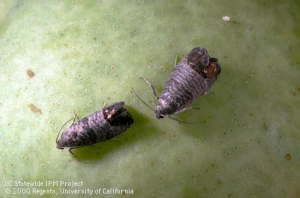It is important to understand how mating disruption affects the ability to monitor codling moth in walnut orchards under mating disruption (MD) as well as in orchards in proximity to MD. Researchers are currently investigating just how far-reaching the impacts of mating disruption are to nearby non-MD blocks. Pheromone-only trapping methods will certainly be impacted in MD blocks, and can be affected in nearby non-MD environments (without the added benefit of substantial disruption, and thus population and damage reduction). Other monitoring methods are necessary in and near MD orchards to effectively manage codling moth populations.
Disruption of sexual communication in moths is thought to function by the following broad types of behavioral mechanisms, and combinations of the two mechanisms:
- Competitive attraction (false-plume-following), in which males are diverted from orienting to females because they are attracted to competing ‘false’ trails emitted by synthetic pheromone dispensers.
- Non-competitive mechanisms, whereby exposure to synthetic pheromone inhibits or blocks the ability of males to sense and/or respond normally to pheromone emitted from females. These include camouflage, desensitization (i.e., adaptation and habituation), and sensory imbalance.

Codling moth adults. Photo credit: Jack Kelley Clark, UC IPM.
In a practical sense, the presence of synthetic pheromone in and around the orchard environment, if effectively impacting mate location/mating success, will impact our ability to use pheromone lures to track population abundance and activity. Codling moth (CM) females emit sex pheromones which elicit responses from males of the species. Therefore, pheromone traps predominantly track only male activity. Successful MD will shut down pheromone traps to zero or very low male catches relative to non-MD environments. In a MD orchard, you will want to monitor pheromone-only traps to gauge this measure of MD effectiveness. However, it is also critical to be able to track flights and relative population abundance to determine if supplemental insecticide treatments are necessary, and to properly time the applications.
Fortunately, there are options available for monitoring CM in/near MD that can overcome trap shutdown by (1) incorporating non-pheromone based lures to trap males, females, or both sexes; and (2) employing additional surveillance methods (non-trap-based) to gauge pest pressure and inform treatment decisions.
- Combination lures:
- Both female and male moths respond to pear ester. This is available in the CM-DA combo lure (contains codlemone, the codling moth pheromone, plus pear ester, a plant volatile-based kairomone). Traps baited with these lures should be used in orchards under MD in addition to pheromone only traps (baited with 1X or L2 lures), necessary to detect trap shutdown as a proxy for efficacy of the MD treatment. If you are concerned with the performance of pheromone-only CM traps in non-MD orchards, consider adding some CM-DA traps, particularly if you suspect you are in proximity to an MD block that is affecting your pheromone trap catches.
- Another option is the three-way lure (CM-DA combo plus acetic acid, AA). Think of this as a ‘super-charged’ lure, which can provide more robust capture in terms of numbers of males and females (in both MD and non-MD orchards).
- With both the CM-DA and CM-DA+AA lures, be cautious in your evaluation of trap numbers. Numbers may be higher or lower than pheromone trap catch numbers, depending on your particular environment (MD, non-MD, near MD), and may not directly correlate with the same moths/trap/night thresholds you are accustomed to.
- Non-trapping methods:
- These surveillance methods involve in-season damage/population estimates via dropped nut counts and canopy counts looking for strikes (visible as small chimneys of frass at the CM entry point). These monitoring methods can and should be incorporated into your IPM program to aid in treatment decisions, regardless of presence of MD and the trap-lure combination you are using.
More information and details regarding these monitoring and treatment options for codling moth are available in the UC IPM Guidelines.
Some thoughts on best practices for lure-based trapping and monitoring in general.
- Storage and handling. Always follow manufacturer guidelines for storage and handling of lures. Most lures are best kept refrigerated or frozen (in non-cycling freezers). It is best to order fresh lures each year, as keeping lures for multiple years can impact performance. If lures are particularly ‘hot’ initially, pre-age lures (open packaging and let them sit out for a day or so) prior to deploying in the field to avoid misinterpretation of activity peaks. Use new traps every year and wear disposable rubber gloves when handling lures and traps to avoid cross-contamination (this will help prevent by-catch of non-target species).
- Interpreting catches and perceived failures. If you are encountering trap catch data that seems unusual, first consider any potential storage, handling, or contamination issues. Next consider other factors, such as new MD blocks in proximity to traps and unusual environmental conditions. Most manufacturers have strict quality control practices; if you have eliminated all other sources of a problem, contact your lure supplier.
- Adopting new trapping techniques. When possible, adopting new monitoring techniques should be a multi-year process, in which new trapping method(s) are introduced alongside those for which historical data is available to help you best understand new results.
- Pesticide applications. Ensure that you are accounting for all treatments and field activities when interpreting trap catches and population activity.
- Interpreting data and making pest management decisions in the field is as much art as science. Although researchers seek to provide the best decision-making guidelines, in reality, there are no exact thresholds and every situation is different. Individual pieces of information, while valuable, often do not provide robust enough evidence to support a “treat” vs. “don’t treat” recommendation. Incorporating knowledge from trap data, other surveillance methods, orchard history, and environmental conditions is critical to developing effective pest management programs that you are confident in recommending.


Leave a Reply